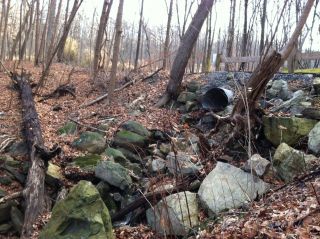Identity
Creepy Spots and Social Bonds
Dark touchstones and the role of small town legends.
Posted December 7, 2013

Troll Bridge
When I went to my hometown over Thanksgiving, I sat at a window to drink coffee, and looked upon a building that once had housed chickens. I recalled that, when I was quite young, I’d gone in and had seen all the little chicks. Only some of them weren’t cute and fuzzy. They were dead. Not just dead, they were flattened.
Sometimes the chicks stampeded, the owner explained, and trampled a few. Well, that image stayed with me. That store became one of my “creepy spots.” Whenever I walked past it, I’d envision those flattened chicks. Even decades later, I still see that image.
Then there were the deteriorating buildings that acquired a reputation for being haunted. One on the edge of town was an old windmill. Little by little, it weathered into a black and gray edifice on a wooded lot before parts began to collapse. Whenever we passed it in the car, I’d strain to see it just to get the shivers. When the roof caved in, it was really creepy.
A house not far from where I lived was truly sinister. I heard that during World War II, a woman who’d lived there had gone crazy and thrown all of her children into the fireplace to keep them from getting some disease. For a long time, I believed this story. I was surprised when a family moved in to renovate the place. They heard that I was a babysitter, so the next thing you know, I’m there inside the haunted house. The kids were asleep and I was the only one awake. I certainly heard noises that could only have been ghosts!
A few miles away, on the road on which I lived, was a psychiatric hospital. This, too, became a creepy place, especially whenever we’d hear that a patient had escaped. We knew that such a person would have to walk or hitchhike on our road, past our house, and this made for some fine stories whenever we camped out in the yard.
Like many kids, we also had countryside lore. The “troll bridge” was one such legend. A gang of us would drive out and sit in the car until some bold soul would get out and go look for the troll. Then the rest of us would follow. Inevitably, we’d be out near the bridge when some dark form we couldn’t quite see would pass between us and the car lights – the troll! This launched a mad scramble to get back in the car and speed away.
Or, we’d go to Denton Road, where it was rumored that a ghost walked around with a lantern, looking for a missing baby. On some nights, you might even hear the baby cry. Supposedly, the lantern-carrier had hanged herself out there on a tree. In fact, when I was in high school, a murder victim’s body was left in a cemetery near Denton Road, as if the killer realized its significance. Or so we believed.
Another creepy spot was the town cemetery. It reportedly had a cold storage house for bodies that had to wait till spring to be buried. I’d walk by the locked doors and imagine dead people inside. But then I’d get nervous about hitchhiker ghosts and leave. It usually took a few nights thereafter before I could sleep without fear that I’d brought some ghostie thing home with me.
As some of us shared these memories over drinks last week, we wondered what kids do today to create their own creepy lore. In my town, the windmill is long gone, the haunted house resembles every other house on that street, and the troll bridge is just an old bridge. But for us, they’d served a function. They'd been social touchstones. Our creepy spots were part of our community identity – and still are. The windmill might be gone, but we all vividly recalled its chilling effect.
Do kids today still go out to their own Denton Roads or spin dread-filled tales about decrepit houses? I certainly hope so.


